
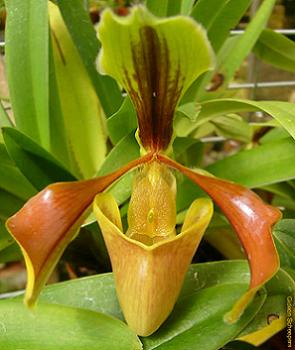 |
annamense.jpg) |
boxallii.jpg) |
| fma. villosum |
var. annamense |
var. boxallii |
Paphiopedilum villosum (Lindley) Stein
- Described: Lindley in Gardener's Chronicle, 1st. series, 14:135 (1854), discovered by Thomas Lobb in Burma in 1853, introduced into cultivation by Mssrs. Veitch & Sons.
- Transferred: Stein in Stein's Orchideenbuch, 490 (1892)
- Etymology: Derived from the latin villosus, meaning hairy; named for the long, soft hairs on the inflorescence, ovary and flower.
- Varieties & Forms:
- Paphiopedilum villosum var. boxallii (Reichenbach fil. in Gardener's Chronicle, 2nd series, 7: 367 (1877)) Pfitzer in Engler & Prantl, Die naturlichen Pflanzenfamilien, II, (6): 83 (1888)
- Paphiopedilum villosum var. annamense Rolfe in Curtis's Botanical Magazine, 133, t. 8126 (1907)
- Paphiopedilum villosum fma. aureum Braem in Orchidees. Culture et Protection, No. 36: 35-38 (1998) - albino form
- Synonyms:
- Cypripedium vernayi Kingdon-Ward in Gardeners' Chronicle, 3rd series, 104: 458 (1938)
- Chromosome Count -
| 2n = |
metacentrics |
telocentrics |
n.f. |
| 26 |
26 |
0 |
52 |
Plant Habit
- Leaves: 4-5, 14-42 cm long, 2-4 cm wide, above light green, below purple-spotted at the base
- Inflorescence: 1-flowered, 7-24 cm long, green spotted purple, white-purple villose
- Bloom: 7-14 cm wide
- Plant: forms large clumps


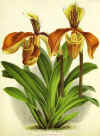

Habitat Data
- Distribution -
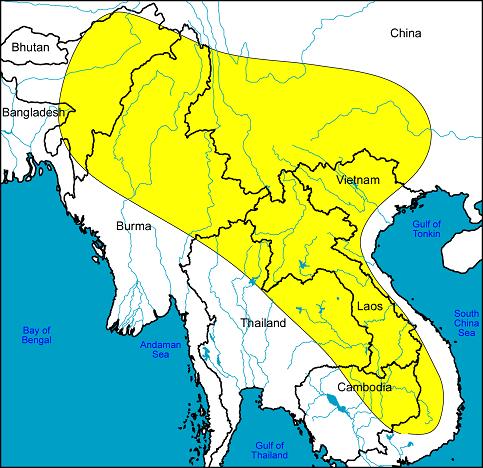
- Elevation: 1400-2000 m
- Peak Flowering in the Wild: April-May
- Ecology: usually found growing in pockets of humus on trees 10-15 m above ground; sometimes found in humus-filled nooks in granite, gneiss or other silicate rocks
- Mean Temperature Range: 8-19° C
- Light: moderate-shade
- Medium: acidic, humus & leaf litter
- Water (D-drier, M-moderate, W-wetter) - Averyanov (2003): "Frequent heavy foggy mists are very typical for these areas which lack a dry season."
| Month |
Jan |
Feb |
Mar |
Apr |
May |
Jun |
Jul |
Aug |
Sep |
Oct |
Nov |
Dec |
| Water |
M |
M |
M |
W |
W |
W |
W |
W |
W |
W |
M |
M |
Notes
- From Van Der Cingel 2001: "In this species the long-distance lure is apparently by colour contrast. Hoverfly pollinators are attracted by the bright yellow staminode in the centre of the flower, surrounded by less attractive, brownish red petals, sepal and upper part of the pouch. The odour is faintly urine-like, suggesting mammalian body fluids which contain salt and are sought after by many insect species, including hoverflies. Close-range attraction is by the glittering staminode, which mimics droplets of moisture and/or species of hoverflies, mainly Episyrphus alternans, Syrphus fulvifacies and Betasyrphus serarius fly to this wart, alight and lose their grip and consequently fall into the pouch. They can only escape up the hind wall and pass the stigma on their way to the exit above the anther. Pollen is attached to the thorax (Banzinger 1994)."
Sources:
- Averyanov, L. et al. Slipper Orchids of Vietnam. Portland, OR: Timber Press, 2003.
- Braem, Guido J., and Guy Chiron. Paphiopedilum. Saint-Genis Laval, France: Tropicalia, 2003.
- Cribb, Phillip J. The Genus Paphiopedilum. Kota Kinabalu, Malaysia: Natural History Publications in association with Royal Botanic Gardens, Kew, 1998.
- Fitch, Charles Marden. "Perky Paphiopedilums: A Bounty of Color and Pattern Awaits Those Who Explore Slipper Orchids." Orchids 73, no. 6 (Jun 2004): 428-33.
- Gruss, O. "Albino Forms of the Slipper Orchids." Orchid Digest 69, no. 4 (Oct/Dec 2005): 204-29.
- Karasawa, K. "Karyomorphological Studies in Paphiopedilum, Orchidaceae." Bulletin of the Hiroshima Botanical Garden 2 (Mar 1979): 1979.
- Tsi ZhanHuo et al. "A Preliminary Report on the Population Size, Ecology, and Conservation Status of Some Paphiopedilum Species (Orchidaceae) in Southwest China." Lindleyana 14, no. 1 (1999): 12-23.
- Van Der Cingel, N.A. An Atlas of Orchid Pollination. Rotterdam, Netherlands: A.A. Balkema, 2001.
Primary Hybrids
| Paph. villosum x |
Hybrid |
| bellatulum |
Allertonense |
| concolor |
Conco-Villosum |
| godefroyae |
Una |
| niveum |
Kirisan |
| boxallii |
Reynaldii |
| charlesworthii |
Wrigleyi |
| druryi |
Winnianum |
| exul |
Vill-exul |
| fairrieanum |
Captain Spender Clay |
| gratrixianum |
Trixivil |
| hirsutissimum |

Germinyanum |
| insigne |
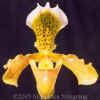
Nitens |
| spicerianum |
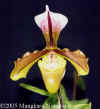
Lathamianum |
| acmodontum |
Howard Brown |
| argus |
Vernixium |
| barbatum |

Harrisianum |
| callosum |

Indra |
| ciliolare |
Pygmalion |
| curtisii |
Helios |
| dayanum |
Iago |
| hennisianum |
Kurt Erdmann |
| hookerae |
Schusterianum |
| javanicum |
Towanda |
| lawrenceanum |
Luridum |
| mastersianum |
Mastersio-Villosum |
| purpuratum |
Concinnum |
| sukhakulii |
Caraibe |
| superbiens |
Charles Canham |
| tonsum |
Theodore Bullier |
| venustum |
Measuresianum |
| wardii |
Shutdown |
| wolterianum |
Talofa |
| glanduliferum |
Vanessa |
| haynaldianum |
Hansenii |
| lowii |
Lucidum |
| parishii |
Rose October |
| philippinense |
Priapus |
| rothschildianum |
Vacuna |
| sanderianum |
Great Pretender |
| stonei |
Abas |
| chamberlainianum |

Madiotianum |
| glaucophyllum |
James Packer |
| primulinum |

Privil Honi |
| victoria-regina |
Venilla |
Return to the Data Sheets Page
Page Created By: Stephen Manza
Last Updated: 10-22-06
contact: silence882@gmail.com



annamense.jpg)
boxallii.jpg)




